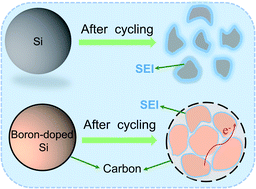Bulk boron doping and surface carbon coating enabling fast-charging and stable Si anodes: from thin film to thick Si electrodes†
Abstract
To address the issues of the particle fracture and loss of electrical connectivity of high capacity silicon anodes, herein, we propose a novel strategy that combines surface carbon coating and bulk boron doping. Heavily boron doped polycrystalline photovoltaic Si particles are used as starting materials. The bulk boron doping is demonstrated to enhance both electron transportation and lithium-ion diffusion, which contributes to superior high-rate performance. Taking advantage of the fast kinetics and stable interphase with the electrolyte, the carbon coated boron doped Si electrode exhibits higher capacity retention. For example, the capacity retentions are 668 mA h g−1, 293 mA h g−1 and 79 mA h g−1 at a high rate of 0.5C (1C = 4000 mA g−1) after 500 cycles for 3900 ppm, 120 ppm, and 10 ppm boron doped Si, respectively. In addition, an improved mass loading of 2.0 mg cm−2, high areal capacity (3.9 mA h cm−2) and high-volume capacity (2111 mA h cm−3) are achieved. Our work opens a new horizon for designing stable high loading Si anodes, which is applicable for other alloy electrode materials.



 Please wait while we load your content...
Please wait while we load your content...